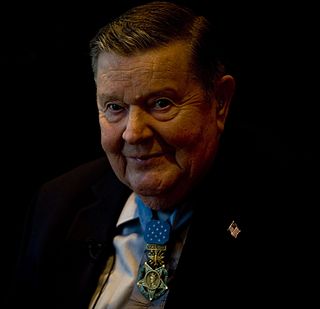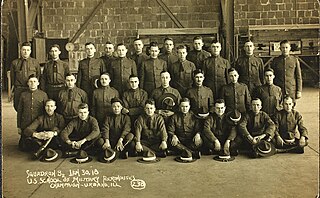United States
The United States Army Air Forces originally favoured officer pilots and the few enlisted pilots were usually civilian-qualified. The adoption of transport and strategic bombing missions meant that a larger number of pilots were needed to perform monotonous and gruelling jobs. Officer pilots were usually assigned to fly fighters and fighter-bombers and commanded units. Enlisted pilots, called flying sergeants with the rank of staff sergeant [4] [5] usually were assigned to fly light reconnaissance and artillery-spotter aircraft, cargo aircraft, and medium- and heavy-weight bombers.
The Flight Officer Act of 1942 created the warrant officer rank of flight officer. All enlisted pilots were promoted to that rank and the rank of flying sergeant was discontinued. The flight officer rank was cancelled in 1945 due to there being adequate numbers of commissioned pilots.
The United States Navy and United States Marine Corps had several programmes to train civilian pilots and enlisted personnel to become naval aviators. There were also programmes to train enlisted men to serve as enlisted pilots to fly torpedo and dive bombers, transport and reconnaissance planes, and airships.
On 17 December 2015, the United States Air Force announced that it would begin training enlisted airmen to fly remotely piloted aircraft, specifically the RQ-4 Global Hawk. [6] The first two enlisted pilots since 1961 soloed on 3 November 2016 at Pueblo Municipal Airport in a Diamond DA20. The first-ever female enlisted pilot completed RPA training at Joint Base San Antonio-Randolph on 3 August 2017. [7]

The United States Air Force (USAF) is the air service branch of the United States Armed Forces, and is one of the eight uniformed services of the United States. Originally created on 1 August 1907, as a part of the United States Army Signal Corps, the USAF was established as a separate branch of the United States Armed Forces in 1947 with the enactment of the National Security Act of 1947. It is the second youngest branch of the United States Armed Forces and the fourth in order of precedence. The United States Air Force articulates its core missions as air supremacy, global integrated intelligence, surveillance and reconnaissance, rapid global mobility, global strike, and command and control.

A flight is a small military unit within the larger structure of an air force, naval air service, or army air corps; and is usually subordinate to a larger squadron. A military aircraft flight is typically composed of four aircraft, though two to six aircraft may also form an aircraft flight; along with their aircrews and ground staff. In some very specific examples, typically involving historic aircraft, a flight may contain as many as twelve aircraft, as is the case with the Battle of Britain Memorial Flight (BBMF) of the British Royal Air Force (RAF). In most usages, two or more flights make up a squadron. Foreign languages equivalents include escadrille (French), escuadrilla (Spanish), esquadrilha (Portuguese), lanka (Ukrainian), patrulă (Romanian), zveno (Russian), and Schwarm (German).

The Nineteenth Air Force is an active Numbered Air Force of the United States Air Force. During the Cold War it was a component of Tactical Air Command, with a mission of command and control over deployed USAF forces in support of United States foreign policy initiatives. The command was reactivated in 1993 under Air Education and Training Command with a mission of conducting AETC's flying training.

A United States Aviator Badge refers to three types of aviation badges issued by the United States Armed Forces, those being for Air Force, Army, and Naval aviation.
The title flight officer was a military rank used by the United States Army Air Forces during World War II, and also an air force rank in several Commonwealth countries, where it was used for female officers and was equivalent to the rank of flight lieutenant. The term flight officer is sometimes used today to describe job title positions as aircrew members.

The Air Education and Training Command (AETC) is one of the nine Major Commands (MAJCOM) of the United States Air Force (USAF), reporting to Headquarters, United States Air Force. It was established 1 July 1993, with the realignment of Air Training Command and Air University.

The 306th Flying Training Group is a unit of the United States Air Force, assigned to Air Education and Training Command (AETC). The group is stationed at the United States Air Force Academy (USAFA) near Colorado Springs, Colorado.

Joe Madison Jackson served as a career officer in the United States Air Force and received the Medal of Honor for heroism above and beyond the call of duty during the Vietnam War. On 12 May 1968, he volunteered for a dangerous impromptu rescue of three remaining Air Force members trapped at an overrun Army Special Forces camp. While the camp was still under heavy enemy fire from North Vietnamese and Viet Cong troops, he skillfully piloted his C-123 cargo plane and rescued the three men.

In the United States Armed Forces, the ranks of warrant officer and chief warrant officer are rated as officers above all non-commissioned officers, candidates, cadets, and midshipmen, but subordinate to the lowest officer grade of O‑1. This application differs from the Commonwealth of Nations and other militaries, where warrant officers are the most senior of the other ranks, equivalent to the U.S. Armed Forces grades of E‑8 and E‑9.
Lieutenant Colonel William Robert "Poppy" Dunn was the first American flying ace of World War II. Joining the Canadian Army at the outbreak of war in 1939, he was an infantryman until he transferred to the Royal Air Force (RAF) in late 1940. After service in an RAF Eagle Squadron, he joined the United States Army Air Forces in 1943. Transferring to the newly established United States Air Force in 1947, he also participated in the Chinese Civil War, Cold War and the Vietnam War.

The 178th Wing is a unit of the Ohio Air National Guard, stationed at the Springfield-Beckley Municipal Airport ANG complex, Springfield, Ohio. If activated to federal service, the wing is gained by the United States Air Force (USAF) Air Combat Command (ACC), with elements of the wing gained by the Air Force Intelligence, Surveillance and Reconnaissance Agency (AFISRA).

The 479th Flying Training Group is a United States Air Force unit, stationed at Naval Air Station Pensacola. A component of Air Education and Training Command, the group was activated on 2 October 2009. The current commander of the 479th Flying Training Group is Colonel Shane “Shamus” Muscato.

The 159th Fighter Squadron is a unit of the Florida Air National Guard's 125th Fighter Wing located at Jacksonville Air National Guard Base at Jacksonville International Airport, Florida. The 159th is currently equipped with the F-15C and F-15D Eagle and is slated to transition to the F-35A Lightning II in 2024.

The 99th Flying Training Squadron is a training squadron of the United States Air Force, part of the 12th Flying Training Wing based at Randolph Air Force Base, Texas.

The United States Army Air Forces during World War II had major subordinate Commands below the Air Staff level. These Commands were organized along functional missions. One such Command was the Flying Training Command (FTC). It began as Air Corps Flying Training Command on 23 January 1942, was redesignated Army Air Forces Flying Training Command (AAFTC) on 15 March 1942, and merged with Army Air Forces Technical Training Command to become Army Air Forces Training Command on 31 July 1943. Continuing service after the war, it was redesignated Air Training Command on 1 July 1946. During the consolidation of Air Force Major Commands in the retrenchment of the 1990s, Air Training Command assumed control of Air University and became Air Education and Training Command on 1 July 1993—today's Air Education and Training Command (AETC), which celebrated its 75th anniversary 23 January 2017. see the Lineage and honors statement for AETC.

The Flying/Aviation Cadet Pilot Training Program was originally created by the U.S. Army to train its pilots. Originally created in 1907 by the U.S. Army Signal Corps, it expanded as the Army's air assets increased.

The Flying Division, Air Training Command, was a training formation of the United States Air Force. The unit was established in 1926 as the Air Corps Training Center to be the primary pilot training center for the Air Corps. It was reorganized into one of three training commands created by the Office of the Chief of the Air Corps in 1940 to accommodate the large number of air cadets being recruited as a result of the expansion of the corps after the fall of France. During World War II, thousands of cadets attended various flight schools throughout the Central United States being trained as pilots for fighters, bombers and transports. It also trained the navigators, bombardiers and gunners necessary for the bombers to attack enemy targets in the combat areas overseas. After World War II, it became the primary pilot and aircrew training unit of the United States Air Force Air Training Command.
The US Navy had four programs for the training of naval aviators.

An officer is a person who holds a position of authority as a member of an armed force or uniformed service.

The aircrews of RAF Bomber Command during World War II operated a fleet of bomber aircraft carried strategic bombing operations from September 1939 to May 1945, on behalf of the Allied powers. The crews were men from the United Kingdom, other Commonwealth countries, and occupied Europe, especially Poland, France, Czechoslovakia and Norway, as well as other foreign volunteers. While the majority of Bomber Command personnel were members of the RAF, many belonged to other air forces – especially the Royal Canadian Air Force (RCAF), Royal Australian Air Force (RAAF) and Royal New Zealand Air Force (RNZAF). Under Article XV of the 1939 Air Training Agreement, squadrons belonging officially to the RCAF, RAAF, and RNZAF were formed, equipped and financed by the RAF, for service in Europe. While it was intended that RCAF, RAAF, and RNZAF personnel would serve only with their respective "Article XV squadrons", in practice many were posted to units of the RAF or other air forces. Likewise many RAF personnel served in Article XV squadrons.

















